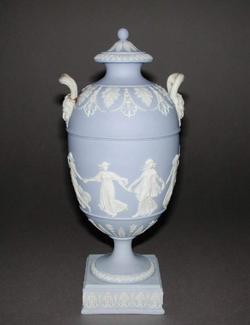Current Location: In storage
Maker(s)
Factory:
Wedgwood
Modeller:
Flaxman, John
(Probably)
Entities
Categories
Description
Jasper, solid pale blue with white reliefs. Ovoid with circular pedestal foot on square plinth, two vertical handles with grotesque masks below on each side of the shoulder, short curved neck with everted rim, and circular domed cover with ball finial and internal cylindrical stopper. The foot and stem are held together by a rod, disk and square nut. The plinth has a border of honeysuckle motifs. The edge of the foot is decorated with alternate acanthus and laurel leaves. The lower part of the vase has alternate stems and elliptical leaves. The sides are decorated with eight female figures holding hands, known as the Dancing Hours, between two raised horizontal bands. On the shoulder there are alternating acanthus leaves and anthemion between palm leaves. On the rim, ovals containing a plant. On the centre of the cover, radiating laurel leaves.
Notes
History note: From the donor's cousin's collection, the late Francis Bedford, Esq.
Legal notes
Given by Mrs James Bedford
Measurements and weight
Height: 24.4 cm
Acquisition and important dates
Method of acquisition: Given
(1911-02-10)
by
Bedford, James, Mrs
Dating
19th Century
Production date:
circa
AD 1800
: c. 1800 or c. 1870-80
Note
First mention of the Dancing Hours was in a letter of early 1778 from Josiah Wedgwood I to to Thomas Bentley (E.25.18847).There is no direct mention of Flaxman having modelled them, but they are mentioned along with the Apotheosis of Homer and Marriage of Cupid and Psyche, which were definitely by him. The Dancing Hours first appeared on a tablet, no. 205 in the 1779 Catalogue . . ., but was also used for mantelpiece friezes, teapots and other wares.
The design for the figures was probably derived from engraved book illustrations after a Greco-Roman marble frieze, The Borghese Dancers or Dancing Hours, now in the Louvre (reserve). See Documentation. Another possible source was a chimney piece of white marble against blue lapis lazuli formerly in the Palazzo Borghese in Rome, which in the 18th century was installed in Moor Park, Herts, home of Sir Lawrence Dundas, and is now in the Lady Lever Art Gallery.
This vase may have been made c. 1800 or in the late 19th century after the reintroduction of solid jasper in 1844.
School or Style
Neoclassical
People, subjects and objects depicted
Components of the work
Reliefs
Materials used in production
Jasper ware
Inscription or legends present
Inscription present: in large type
- Text: WEDGWOOD
- Location: On underside of plinth
- Method of creation: Impressed
- Type: Mark
References and bibliographic entries
-
Admiranda Romanorum Antiquitatum . .
-
L'Antiquité expliqué et representée en figures
page(s): p. 199
-
A catalogue of cameos, intaglios, medals, busts, small statues, and bas-reliefs; with a general account of vases and other ornaments, after the antique, made by Wedgwood & Bentley, and sold at their rooms in Great Newport Street, London.
-
Decorative Wedgwood in Architecture and Furniture
page(s): p. 64
-
Taste and the Antique. The Lure of Classical Sculpture 1500-1900
page(s): pp. 195-6
-
Wedgwood
page(s): pp. 505, 509
-
John Flaxman, R.A.
page(s): p. 54
-
Dictionary of Wedgwood
page(s): pp. 114-5
-
Good European Ceramics, Glass and Enamels
page(s): p. 246
-
Wedgwood, The New Illustrated Dictionary
page(s): pp. 128-9
Identification numbers
Accession number: C.16.1 & A-1911
Primary reference Number: 11480
Stable URI
Audit data
Created: Saturday 6 August 2011
Updated: Monday 4 August 2025
Last processed: Monday 4 August 2025
Associated departments & institutions
Owner or interested party:
The Fitzwilliam Museum
Associated department:
Applied Arts





